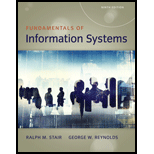
Fundamentals of Information Systems (Looseleaf)
9th Edition
ISBN: 9781337099042
Author: STAIR
Publisher: Cengage
expand_more
expand_more
format_list_bulleted
Question
Chapter 9, Problem 1LO
Program Plan Intro
The reason computer incidents are so prevalent.
Expert Solution & Answer
Program Description Answer
Complexity, incorrect authentication, compromised login details, technological advancements, delay in getting fixes are some of the reasons responsible for computer incidents.
Explanation of Solution
Computer incident is any act which compromises the security of data of computer system or access to system.
Some of the most prominent reasons for computer incidents are discussed below:
- Increased complexity: Internet has increased complexity as it has allowed interconnection of various devices with new technologies emerging every other day. Websites, system applications, cloud computing, laptops, computer systems, mobile devices, and networks interconnected through the internet is becoming a mix of a complex environment. With increased complexity, there are more security breaches due to a number of entry points through which security can be compromised.
- Incorrect authentication: Customer care service is one area where security is most compromised as they are under constant high pressure from customers to solve their query at fast pace, which results in a security breach. In order to provide fast help service sometimes they forget to authenticate a person and give away confidential information. Sometimes login and passwords are shared among users of organization due to many reasons, for instance if someone forgets their password, he/she is provided with login credentials of another colleague, which results in unauthorized access to information.
- Technological advancement: Earlier all the data related to company’s operation used to be stored in a locked room with minimum access, but now a days with expanded business needs, globalization, collaborative working and new technological breakthrough this information is being shared on networks with millions of other computers. However, tools which are required for securing data are not getting developed by IT organizations at the pace of technological advancements, which can perform assessment of new risks that are added every day with newly added technology.
- Bringing your own device (BYOD) policy: Employee’s access company data by using their devices such as a mobile, tablet, personal laptops to have all time availability and connection with the work, which generates a security threat. Most of these devices may not have up to date security software and they can be used to access websites which may allow malware or virus to creep in organization network and compromises the security of other network devices.
- Delay in software updates: Commercial software when detects security threat, develop and issue fix or patch to resolve the problem. Most of the organization do not understand the upcoming risks and delay these software updates for multiple reasons such as time shortage, extra cost involved or just negligence, making the organization’s computer vulnerable to attack.
Want to see more full solutions like this?
Subscribe now to access step-by-step solutions to millions of textbook problems written by subject matter experts!
Students have asked these similar questions
/2
14.
sin² 20 cos³ 20 de
10.
8 sin¹ y cos² y dy
Ln (z+1)
dz, C: |zi| = 1.4
-
17.
z 2 + 1
C
Chapter 9 Solutions
Fundamentals of Information Systems (Looseleaf)
Ch. 9 - Prob. 1LOCh. 9 - Prob. 2LOCh. 9 - Prob. 3LOCh. 9 - Prob. 4LOCh. 9 - Prob. 5LOCh. 9 - Prob. 1.1RQCh. 9 - Prob. 1.2RQCh. 9 - Prob. 1.1CTQCh. 9 - Prob. 1.2CTQCh. 9 - Prob. 2.1RQ
Ch. 9 - Prob. 2.2RQCh. 9 - Prob. 2.1CTQCh. 9 - Prob. 2.2CTQCh. 9 - Prob. 1SATCh. 9 - Prob. 2SATCh. 9 - Prob. 3SATCh. 9 - Prob. 4SATCh. 9 - Prob. 5SATCh. 9 - Prob. 6SATCh. 9 - Prob. 7SATCh. 9 - Prob. 8SATCh. 9 - Prob. 9SATCh. 9 - Prob. 10SATCh. 9 - Prob. 11SATCh. 9 - Prob. 12SATCh. 9 - Prob. 13SATCh. 9 - Prob. 14SATCh. 9 - Prob. 1RQCh. 9 - Prob. 2RQCh. 9 - Prob. 3RQCh. 9 - Prob. 4RQCh. 9 - Prob. 5RQCh. 9 - Prob. 6RQCh. 9 - Prob. 7RQCh. 9 - Prob. 8RQCh. 9 - Prob. 9RQCh. 9 - Prob. 10RQCh. 9 - Prob. 11RQCh. 9 - Prob. 12RQCh. 9 - Prob. 13RQCh. 9 - Prob. 14RQCh. 9 - Prob. 15RQCh. 9 - Prob. 16RQCh. 9 - Prob. 1DQCh. 9 - Prob. 2DQCh. 9 - Prob. 3DQCh. 9 - Prob. 4DQCh. 9 - Prob. 5DQCh. 9 - Prob. 6DQCh. 9 - Prob. 7DQCh. 9 - Prob. 1PSECh. 9 - Prob. 2PSECh. 9 - Prob. 1WECh. 9 - Prob. 2WECh. 9 - Prob. 3WECh. 9 - Prob. 1CECh. 9 - Prob. 2CECh. 9 - Prob. 3CECh. 9 - Prob. 1.1CSCh. 9 - Prob. 1.2CSCh. 9 - Prob. 1.3CSCh. 9 - Prob. 2.1CSCh. 9 - Prob. 2.2CSCh. 9 - Prob. 2.3CS
Knowledge Booster
Similar questions
- 15 OF 25 QUESTIONS REMAININ Consider the following code. You want to print the array values in the div as an ordered list. What statement would you use to replace the comment in the code below? Two J // what statement goes here? - لبية للالكالا const app = Vue.createApp({ data (( return ( lunch: [ 'Burrito', 'Soup', 'Pizza', 'Rice' }) app.mount ('#app6') - -arrow_forwardPlease answer JAVA OOP problem below: Assume you have three data definition classes, Person, Student and Faculty. The Student and Faculty classes extend Person. Given the code snippet below, in Java, complete the method determinePersonTypeCount to print out how many Student and Faculty objects exist within the Person array. You may assume that each object within the Person[] is either referencing a Student or Faculty object. public static void determinePersonTypeCount(Person[] people){ // Place your code here }arrow_forwardPlease answer JAVA OOP question below: Consider the following relationship diagram between the Game and VideoGame data defintion classes. Game has a constructor that takes in two parameters, title (String) and cost (double). The VideoGame constructor has an additional parameter, genre (String). In Java, efficiently write the constructors needed within the Game class and VideoGame classes. Hint: Remember to think about the appropriate validationarrow_forward
arrow_back_ios
SEE MORE QUESTIONS
arrow_forward_ios
Recommended textbooks for you
 Principles of Information Systems (MindTap Course...Computer ScienceISBN:9781285867168Author:Ralph Stair, George ReynoldsPublisher:Cengage Learning
Principles of Information Systems (MindTap Course...Computer ScienceISBN:9781285867168Author:Ralph Stair, George ReynoldsPublisher:Cengage Learning Enhanced Discovering Computers 2017 (Shelly Cashm...Computer ScienceISBN:9781305657458Author:Misty E. Vermaat, Susan L. Sebok, Steven M. Freund, Mark Frydenberg, Jennifer T. CampbellPublisher:Cengage Learning
Enhanced Discovering Computers 2017 (Shelly Cashm...Computer ScienceISBN:9781305657458Author:Misty E. Vermaat, Susan L. Sebok, Steven M. Freund, Mark Frydenberg, Jennifer T. CampbellPublisher:Cengage Learning Management Of Information SecurityComputer ScienceISBN:9781337405713Author:WHITMAN, Michael.Publisher:Cengage Learning,
Management Of Information SecurityComputer ScienceISBN:9781337405713Author:WHITMAN, Michael.Publisher:Cengage Learning, Fundamentals of Information SystemsComputer ScienceISBN:9781337097536Author:Ralph Stair, George ReynoldsPublisher:Cengage Learning
Fundamentals of Information SystemsComputer ScienceISBN:9781337097536Author:Ralph Stair, George ReynoldsPublisher:Cengage Learning

Principles of Information Systems (MindTap Course...
Computer Science
ISBN:9781285867168
Author:Ralph Stair, George Reynolds
Publisher:Cengage Learning

Enhanced Discovering Computers 2017 (Shelly Cashm...
Computer Science
ISBN:9781305657458
Author:Misty E. Vermaat, Susan L. Sebok, Steven M. Freund, Mark Frydenberg, Jennifer T. Campbell
Publisher:Cengage Learning



Management Of Information Security
Computer Science
ISBN:9781337405713
Author:WHITMAN, Michael.
Publisher:Cengage Learning,

Fundamentals of Information Systems
Computer Science
ISBN:9781337097536
Author:Ralph Stair, George Reynolds
Publisher:Cengage Learning